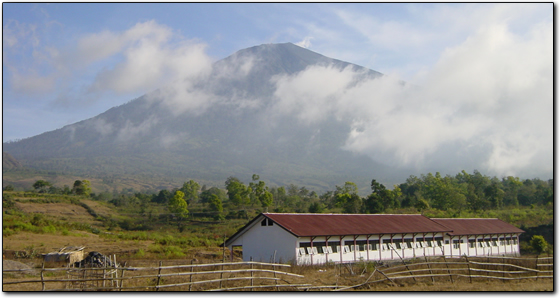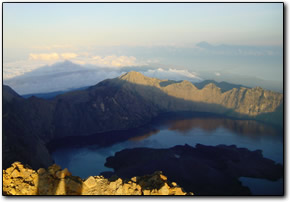
Gunung Rinjani
After a few days in Tetebatu, it was time to climb the volcano. We caught a bus going to the north side of Lombok. When it stopped at a junction to pick up more passengers, sack after sack of rice was loaded onto the roof. With about a ton of rice on the roof, the bus whined and groaned its way up the steep road leading over the eastern shoulder of one of the ridges that tumbles down from the volcano. On the other side of the pass was a green, fertile bowl surrounded by steep hills. The summit of Rinjani loomed above us like a giant, tilting cone. The 3800m summit appeared only a deceptively short jaunt away. The friendly staff of the national park office helped us to find a guide and a porter. Tents, stoves, sleeping bags and even sweaters and jackets were for rent. We teamed up with a Belgian couple to share the costs. By the time we went shopping for supplies, it was already dark, but we needed tea, coffee, sugar, rice and instant noodles for the trek. We found a store in the village and ordered supplies, haggling over each item. Soon villagers gathered around to watch the fun as we bargained, their eyes shifting from the vendor to our faces as if it were a tennis match. Some of the onlookers nodded with approval when we managed to reduce an excessively high price on a particular item. If the store did not carry what we wanted, the locals rushed to supply us from their own stores.
 |
The first day's trekking up the crater rim was a long, hard slog through hot, dry, dusty grassland. It looked much closer than it really was, and we stopped too long by one of the only springs to cook lunch. A grass fire raged over the trail ahead: menacing, but not particularly dangerous. We arrived at the campsite just as the sun was disappearing over the horizon: an incredible red, yellow and purple sunset with the summit of Mt. Agung on Bali in the distance. Eric was too tired to eat. He went straight to bed, wrapping himself in his warm jacket. We were hounded all night by gusts of wind that racked our tent as we huddled in our sleeping bags, fully clothed. At around 3am we woke to start the summit climb. Anne chose to stay in bed, so Eric climbed with the Belgians, alone, as our guide had also decided not to bother. There was just enough moonlight to see the faint trail to the summit ridge. It was a long, hard climb: very tough going in places because the ground was covered with volcanic pebbles.
 |
 |
Some people gave up when they saw the final stretch leading to the summit: a ramp of loose, slippery volcanic rocks. It was impossible to take slow, steady steps without slipping back. Sudden, staggering bursts of forward movement followed by long gasps for breath with firmly planted feet seemed the only way to make progress, and it seemed to take forever. Danau Segara Anak, Rinjani's volcanic lake called the “child of the sea”, spread out below the crater rim, its dark water still untouched by the early light. Above, the rays of the rising run projected the shadow of the volcanic cone on the distant clouds. When Eric finally arrived at the summit, the sun was already well over the horizon, warming him on the windy outcrop with a feeble heat. Most of the island was visible in a grand panorama, from the three Gili islands to the west, gleaming like pearls in the ocean, to the dusky eastern shores. Mt. Agung poked above the clouds in the far distance. Below, Mt. Baru, surrounded by a black-and-purple lunar wasteland, cut a giant crescent from the oblong crater lake.
 |
 |
After Eric returned to camp we set off for the shore of Danau Segara Anak. There was a place to camp by the lake with hot springs. Everything was full of trash. Indonesians had invaded the hot springs, turning the area into what looked like a refugee camp. The hot water had the reputation as a cure for skin diseases; perhaps this was what had attracted so many long-term guests. The next day we hiked back over the crater wall and returned to park headquarters.
 |
 |
After Rinjani we spent a few days on Gili Meno, one of the small islands near the western shore of Lombok. We had a rundown bungalow right on the beach in an isolated part of the island. Turning over the mattress, we discovered a large gecko in our bed. Our stay was brief. There was only salt water for washing and the coral was in very poor shape: bleached, with no fish.

